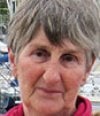A pilot scheme on Strangford Lough, which is trying to stimulate seagrass growth on the seabed by testing alternative mooring systems, has been reported by BBC News NI.
Last April, Afloat highlighted a project initiated by the Strangford and Lecale Partnership which started a new pilot study of Advanced Mooring Systems in Strangford Lough. It was the first study of its kind in Northern Ireland to focus on eco-friendly moorings which could avoid or limit the damage caused to the seafloor habitats and species by the swinging chain of traditional boat moorings
Seagrass is a flowering plant able to live in seawater, and its ability to absorb carbon is thought to be greater than that of trees.
The moorings had been laid in Ballyhenry Bay just north of Portaferry on the Strangford Narrows, which DiveNI describes as “a well-established seagrass (Zostera marina) bed with large blades, although it can be patchy in places, especially due to scouring from moorings”.
 Dr David Smyth, who inspected the area, says each mooring ship is damaging around a 6m (19.7ft) circle of seabed Photo: BBC News NI
Dr David Smyth, who inspected the area, says each mooring ship is damaging around a 6m (19.7ft) circle of seabed Photo: BBC News NI
BBC NI News says, “According to Darren Rice of Newry, Mourne and Down District Council's geopark team, the traditional mooring system can scar the bottom of the seabed and get rid of the seagrass”. It seems that the mooring systems laid last year are now the subject of the survey. He continues, “We are currently surveying two new advanced mooring systems to see which ones are best for Strangford Lough. So we are hoping these systems will lift the chain off the seabed and allow the seagrass to recover, and that will allow all of the biodiversity to rush back in."
 Zostera marina or Seagrass Photo: National Museum of Nature and Science, Tokyo
Zostera marina or Seagrass Photo: National Museum of Nature and Science, Tokyo
On inspection of the trial moorings Conservation Officer Dr David Smyth found, “Beyond the chain of the mooring the seagrass is in pretty good shape; it has a good root system and is well intact into the substrate. But where the chain has swung around the mooring block, it is pretty scarred up. One on its own isn't a particularly big problem, but if you have 10 to 15 of them, you are taking out a six-metre circle with the chain moving in the tide. That's removing that seagrass, that carbon capture plant that everybody is very excited about."
The many sailing clubs around the Lough have mooring sites in dozens of locations, and there are many private moorings as well.
Commercial diver Jonathan Connor was also among those inspecting the trial site, and they found that a few pieces of the chain were missing, so they were replaced.
This pilot scheme is expected to continue for several years to change nothing above the water but stimulate life below.































































